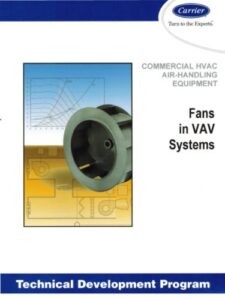Carrier TDP 613 HVAC Fans in VAV Systems
Carrier TDP 613 HVAC Fans in VAV Systems
Technical Development Programs (Carrier TDP 613 HVAC Fans in VAV Systems) are modules of technical training on HVAC theory, system design, equipment selection and application topics. They are targeted at engineers and designers who wish to develop their knowledge in this field to effectively design, specify, sell or apply HV AC equipment in commercial applications.
One of the reasons that VA V (Variable Air Volume) systems are popular is because they provide fan energy savings that constant volume systems cannot. As a general statement, fans consume more energy in a typical HVAC system than the compressors. Therefore, it is important that the correct type of VA V fan be used for the application. Equally important is that the fan in a VAV system is stable at part load operation, as well as full load operation. This TDP module will explain the types of fans that can be used in VA V systems, as well as the controls that may be applied to regulate each.
You can also read Carrier TDP 612 HVAC Fans Features and Analysis
Carrier TDP 613 Content
- Introduction
![Carrier TDP 613 HVAC Fans in VAV Systems]()
- Fan Impact
- Fan Types
- Centrifugal Fans
- Axial Fans (In-Line)
- Centrifugal Fans
- Impeller Design
- Forward-Curved
- Airfoil and Bacb vard -Inclined
- Plenum Fan
- Axial (In-line) Fans
- Fan Volume Contro l
- Controllable Pitch Axial
- Modudrive
- Discharge Damper
- System Bypass
- No Volume Control (Riding the Fan Curve)
- Inlet Guide Vanes
- Variable Frequency Drives
- Eddy Current Couplings
- Fan Stability
- Fan Selection
- VFD Energy Savings in VA V Systems
- VAV Fan Control
- Fan Tracking and Building Pressurization
- Supply and Return Fan Configuration
- Supply and Exhaust Fan Configuration
- Summary
- Work Session
- Appendix
- Fan Static hp Equation
- Fan Heat Equation
- Work Session Answers
Building heat loads change throughout the seasons due to variations in outside temperature and shift of solar load patterns. Additionally, building occupant and lighting load patterns change as building space use varies. An air-conditioning system must be able to match these varying load patterns while minimizing the use of energy.


Comments are closed.